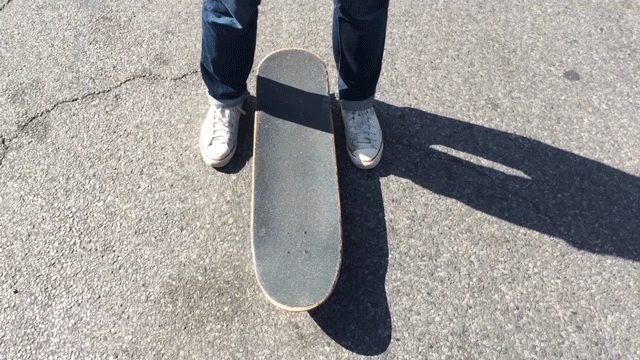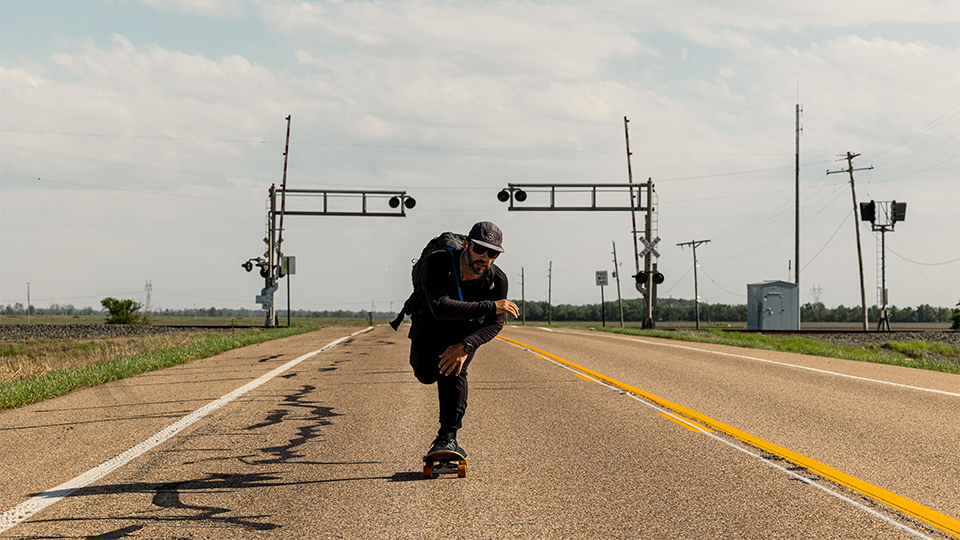
Since the beginning of time, skateboarders have pondered one universal mystery: What makes you Goofy or Regular? Is it based on what hand you wipe your ass with? What leg you kick a ball with? How much milk you drank as a kid?
Rumor has it the term “goofy” itself comes from the 1937 Disney cartoon, “Hawaiian Holiday,” in which Goofy the dog surfs with his right paw forward, but it gives us no insight into what determines one’s stance.
Bi-stance-ual skaters like P. Rod tha God and Leandre Sanders, the Venice local who skates street regular but bowls goofy, have shown us that stance is something we can figure out, if only we try. So I put on my nerdiest glasses, dusted off my college diploma, and decided to see if I could crack the stance code.
(DISCLAIMER: Mongo pushers, being the black hole of wackiness that it is, could be neither tolerated by or included in this investigation. More importantly, I couldn’t find any mongo pushers to include in my studies.)

Does being right-handed or left-handed determine your skate stance?
No.
Of the 4,000 skaters in the Skatepark of Tampa Database, about half are goofy (44%) and half are regular (56%). But this near equality between skate stances doesn’t align with statistics on handedness. According to Scientific American, 90% of people are right-handed.
I even conducted a *highly scientific* survey to examine the handedness link. After talking to six left-handed skaters about their stances, five said they were regular and one said he was goofy. So right-handed skaters aren’t always regular footed, and left-handed skaters aren’t always goofy footed. Myth busted, motherfuckers!
But if handedness has nothing to do with skate stance, and someone like Leandre can skate both goofy and regular, I wondered if stance might not even be a bodily predisposition. Thankfully, someone wrote a book on the topic. In Laterality: Exploring the Enigma of Left-Handedness, Dr. Clare Porac explains that most people use their right foot for action tasks, like kicking a ball, and their left foot for stability tasks, like standing on one leg. However, these categories are malleable.
Riverdancers, for instance, are required to stand on their left legs and kick with their right legs. It’s just part of the dance. But after enough time standing on their left feet, Riverdancers whose left feet are usually their “action” feet end up finding their “action” and “stability” feet becoming switched. Meaning if they used to kick a ball with their left foot and balance on their right foot, now they prefer to use their right foot to kick and their left to stand.
Could that mean something in our footedness holds the clue to our stance?

Does your “action” foot determine your stance?
No.
In her book, Porac cites a common statistic that 85% of people have a right “action” foot. However, the method for testing a person’s “action” footedness doesn’t involve skating. The easiest test consists of kicking a soccer ball. So 85% of people might prefer to kick with their right foot, but, obviously, not 85% of skateboarders push regular (with their right foot).
Because I’m such a nerd I decided to conduct another *scientific* survey, this time about footedness. Of the 45 skaters who completed my survey, 44% of them said they were goofy footed. This was right in line with Skate Park of Tampa’s database numbers and demonstrated that a skater’s “action” foot isn’t always the same as his pushing foot.
So if your “action” foot doesn’t determine your stance, could your “stability” foot be responsible? Luckily I included that in my last *scientific* survey as well.

Does your “stability” foot determine your stance?
Most likely.
Of the 45 skaters in my survey, the regular footed ones said they always used their left feet for “stability” tasks, like balancing on one foot. Another test that determines which foot is your preferred “support foot” is thinking about which foot you use to support yourself on when getting up onto a table or stool. Most of the goofy footed skaters said they used their right feet for “stability” tasks, but a good number of them said they had no preference between their right or left feet for doing “stability” tasks.
These findings are far from conclusive, but they do suggest that the foot you prefer to stand on for support tasks will usually be your front foot on your board.

Where to go from here?
The two takeaways from my loosly “scientific” endeavors are:
1. As expected, stance is not based on random chance. There’s a reason we all feel a preference about our feet positioning the first time we jump on a board, and you should be able to figure out the origin of your stance by seeing which foot you’re more comfortable balancing on. Or you can apply the classic “push test” on your unsuspecting homies to figure out their stances.
2. Stance isn’t permanent. If you really want to change your stance from regular to goofy or from goofy to regular, or even be truly stanceless, you can. Just like the fucking Riverdancers, with equal and deliberate practice skating in both stances early on, you could become a stanceless anomaly like Leandre (and get co-oped by the Olympics).
Comments
Popular
-
 A LOOK AT THE SKATEBOARD DROUGHT OF 2020
A LOOK AT THE SKATEBOARD DROUGHT OF 2020
If you’ve walked into a skate shop lately, you may have had some difficulty getting your hands on the product you came in for.
-
 KEITH HUFNAGEL ON THE FUTURE OF HUF
KEITH HUFNAGEL ON THE FUTURE OF HUF
We heard a rumor that HUF was going out of business, so we talked with boss man himself to find out.
-
 A LOOK AT THE CULT OF INDEPENDENT TRUCKS
A LOOK AT THE CULT OF INDEPENDENT TRUCKS
WARNING: This article is strictly for the nerdiest of skate nerds.
-
 GETTING KINKY WITH DANIEL VARGAS
GETTING KINKY WITH DANIEL VARGAS
Daniel Vargas' philosophy on whips, chains and getting choked out.
-
 “ACROSS AMERICA” DOCUMENTS THE TRIALS AND TRIBULATIONS OF SKATING ACROSS THE COUNTRY
“ACROSS AMERICA” DOCUMENTS THE TRIALS AND TRIBULATIONS OF SKATING ACROSS THE COUNTRY
Watch the behind-the-scenes reality of Chad Caruso's world record skate in this new documentary.

June 16, 2022 12:54 am
Did you take into account mango pushers? In curious as to why they prefer to have their foot on the back of the board
Leave a reply
July 9, 2022 6:12 pm
Yo I’m regs but I’m a righty
And I skated mongo for years
(4years)
Before I switched to pumping
My r leg
Skateboards defy all physics
While still adhering to all the laws
Leave a reply
November 22, 2022 12:19 am
As a ballet dancer, we alternate the stability foot in class and choreography but always have a preferred side (or foot) for pirouettes etc. that comes more naturally and thus is stronger as we tend to dance to that preferred side. This foot preference begins at a very early age and could be associated with any of the stabilising factors that assist in ballet turnout starting with SI joint rotation in the hip, following down through the knee and then the ankle. I would suggest that the innate preferred foot in ballet comes from the individual dancer’s physiology and is determined through proprioception and early training.
Having read this article I now finally understand why I surf and skate goofy as my preferred stabilisation foot is my right foot.
Leave a reply
July 13, 2025 5:03 am
I’m goofy footed, right handed and my stability foot is my left… I personally find this inconclusive
Leave a reply